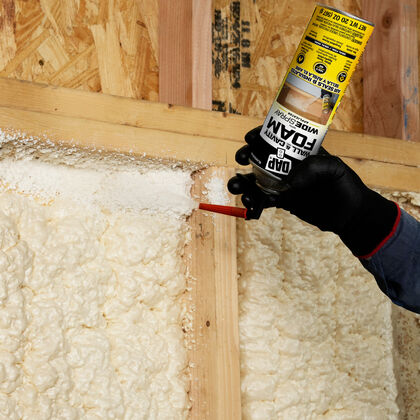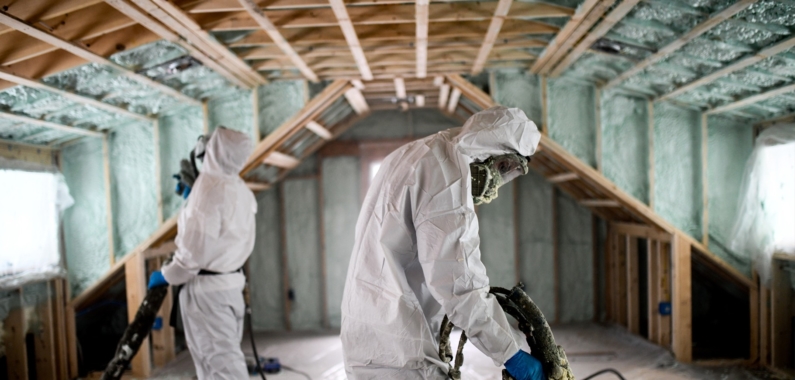Comprehending the Benefits of Using Spray Foam for Insulation Projects
Comprehending the Benefits of Using Spray Foam for Insulation Projects
Blog Article
Spray Foam: The Ultimate Remedy for Air Sealing and Insulation
Spray foam insulation has become a leading solution for efficient air securing and thermal insulation, providing an one-of-a-kind combination of residential or commercial properties that establish it apart from standard methods. Its capability to increase and fill spaces makes it specifically effective in stopping air leakage, which can dramatically impact power performance. Understanding the full scope of its advantages, installation procedures, and contrasts with other insulation kinds is important for making educated decisions. As we discover these facets, the effects for both brand-new buildings and retrofits end up being progressively substantial. What factors should influence your choice?
What Is Spray Foam?
Spray foam is a versatile insulation material that incorporates the concepts of air securing and thermal resistance to enhance power performance in buildings. Made up largely of polyurethane or various other similar substances, spray foam is applied as a fluid that broadens upon call with surface areas, producing a strong, continual layer of insulation. This distinct residential or commercial property permits it to load spaces, splits, and voids that typical insulation materials may ignore, offering a superior air seal.
There are 2 main kinds of spray foam: open-cell and closed-cell. Open-cell spray foam is lighter and much more adaptable, using excellent audio absorption and a lower R-value per inch - Spray Foam. In comparison, closed-cell spray foam is denser, giving a higher R-value, dampness resistance, and added architectural integrity to developing components
The application process usually involves specific tools, guaranteeing a smooth application that follows different substrates, including concrete, wood, and metal. This adaptability makes spray foam appropriate for both brand-new constructions and retrofitting existing frameworks. Its capacity to create a closed obstacle significantly adds to lowering energy usage and enhancing interior air quality, consequently making it a recommended choice among homeowners and building contractors alike.
Benefits of Spray Foam Insulation
One of one of the most substantial benefits of spray foam insulation is its outstanding ability to produce a continual air barrier, which successfully decreases energy loss. Unlike typical insulation materials, spray foam broadens to fill up fractures and gaps, guaranteeing that air leakage is considerably reduced. This characteristic not just boosts energy performance yet likewise leads to lower utility expenses in time.
Furthermore, spray foam insulation gives remarkable thermal resistance, adding to an extra stable indoor environment. Its high R-value per inch permits for reliable insulation in confined rooms, making it suitable for attics, walls, and crawl areas. Additionally, the moisture-resistant buildings of spray foam assistance prevent mold and mildew and mildew growth, promoting healthier living problems.
Another essential benefit of spray foam insulation is its sound-dampening high qualities (Spray Foam). It properly decreases sound transmission in between areas, developing a quieter and much more comfortable home atmosphere. The resilience of spray foam also attracts attention, as it does not droop or settle gradually, preserving its efficiency throughout its lifespan
Exactly How Spray Foam Works
Recognizing how spray foam insulation works is vital for appreciating its performance in air securing and thermal resistance. Spray foam insulation is composed of 2 primary parts: isocyanate and polyol resin. When these elements are combined, they undertake a chain reaction that creates the material to broaden quickly, developing a thick foam that fills tooth cavities, voids, and cracks.
As the foam expands, it abides by surfaces, developing a closed seal that considerably reduces air infiltration. This particular makes spray foam insulation very efficient at Spray Foam avoiding drafts and moisture penetration, which can result in power loss and damage with time. Additionally, the closed-cell version of spray foam provides exceptional thermal resistance as a result of its inflexible structure, successfully lessening warm transfer.
The distinct residential properties of spray foam allow it to comply with irregular surface areas, making sure detailed protection and a seamless obstacle. As an outcome, spray foam insulation not just enhances energy efficiency however additionally view adds to enhanced interior air high quality by decreasing the buildup of allergens and toxins. Ultimately, recognizing the mechanics behind spray foam highlights its duty as a premium choice for insulation and air sealing in both business and household applications.
Setup Process Overview

Prior to installment, the space should be appropriately cleansed and prepped, ensuring that surface areas are cost-free from debris, dirt, and dampness. This step is critical since impurities can jeopardize adhesion and general performance. When the area is prepared, the application involves mixing both elements of the spray foam, which expands upon call and fills up voids successfully.
Educated specialists need to conduct the installation, utilizing customized tools to make certain consistent protection and optimal thickness. Security safety measures, consisting of using protective gear and guaranteeing correct air flow, are necessary throughout this procedure. After application, the foam usually cures promptly, creating a solid barrier that improves energy efficiency.
Comparing Spray Foam to Typical Insulation
When examining insulation options, spray foam insulation stands out in comparison to traditional products such as fiberglass and cellulose. Unlike fiberglass and cellulose, which can permit air seepage, spray foam expands upon application, filling up gaps and gaps to develop an airtight seal.
In addition, spray foam provides a higher R-value per inch than standard insulation types, offering even more effective thermal resistance in a thinner profile. This particular is particularly helpful in rooms with limited cavity depth. Spray foam is resistant to wetness and mold development, which can be a considerable concern with cellulose and fiberglass, especially in moist atmospheres.
However, spray foam insulation typically lugs a greater ahead of other time expense than its typical equivalents. Homeowners should evaluate this first investment against lasting energy financial savings and performance advantages. Ultimately, while both insulation types serve their purpose, spray foam arises as an advanced remedy for contemporary insulation demands, especially in terms of air securing and thermal effectiveness.

Verdict
In recap, spray foam insulation represents a highly effective option for accomplishing optimum air securing and thermal resistance. Its one-of-a-kind residential or commercial properties, including wetness resistance and sound dampening, make it appropriate for different applications in both brand-new building and constructions and retrofitting projects (Spray Foam). Although the first costs might be higher contrasted to conventional insulation materials, the lasting advantages, such as significant energy savings and improved indoor air quality, justify the investment and underscore its worth in modern building methods.
Spray foam insulation has actually emerged as a leading solution for efficient air securing and thermal insulation, supplying a special mix of properties that establish it apart from typical approaches.Spray foam is a flexible insulation product that integrates the concepts of air securing and thermal resistance to enhance power efficiency in structures.When assessing insulation options, spray foam insulation stands out in contrast to typical materials such as fiberglass and cellulose. Ultimately, while both insulation types offer their purpose, spray foam emerges as an extra advanced option for modern insulation requirements, especially in terms of air securing and thermal efficiency.
In summary, spray foam insulation stands for a very efficient solution for accomplishing optimum air sealing and thermal resistance.
Report this page